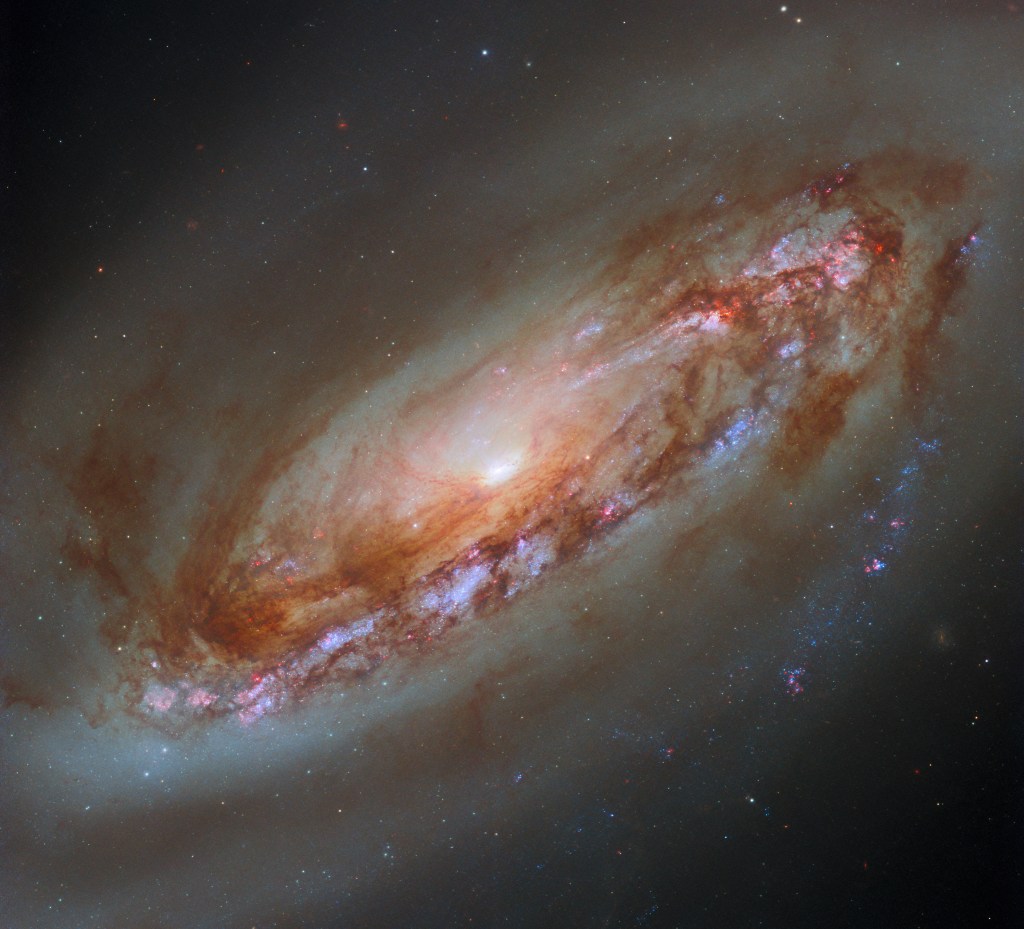Captivating Image of Messier 90: A Closer Look at the Spiral Galaxy from the Hubble Space Telescope
The universe continually fascinates us with its vastness and beauty, and few tools have allowed us to explore these wonders more profoundly than the Hubble Space Telescope. Jointly operated by NASA and the European Space Agency (ESA), Hubble has been instrumental in capturing breathtaking images of galaxies far beyond our reach. Among these is the majestic spiral galaxy Messier 90, also known as M90 or NGC 4569, located in the Virgo constellation. This article delves into the details of this striking celestial body and the technological marvels that have enabled us to view it in such detail.
A Journey to the Heart of Virgo
Messier 90 is one of the Virgo Cluster’s most intriguing members, a collection of galaxies situated approximately 60 million light-years from Earth. Despite this seemingly insurmountable distance, the Hubble Space Telescope has managed to capture detailed images of this galaxy, offering us a glimpse into its structure and components.
In 2019, Hubble released a compelling image of M90, which was originally captured using the Wide Field and Planetary Camera 2 (WFPC2). This camera was installed on the Hubble Space Telescope in 1994 and quickly began sending back images that would reshape our understanding of the universe. Although the WFPC2 image of Messier 90 had a distinctive stair-step pattern due to its sensor layout, it still provided invaluable insights into the galaxy’s structure.
Advancements in Imaging Technology
The year 2009 marked a significant upgrade for the Hubble Space Telescope with the installation of the Wide Field Camera 3 (WFC3). This new camera was designed to replace the older WFPC2, offering enhanced capabilities and clearer imaging. The WFC3 is equipped with a wide range of filters, allowing it to capture images across various wavelengths, from ultraviolet to near-infrared. This versatility enables astronomers to study galaxies like Messier 90 in unprecedented detail.
When Hubble refocused its attention on Messier 90 in 2019 and again in 2023, it used the WFC3 to collect new data. The result was a stunning and comprehensive image that showcased the galaxy’s features more vividly than ever before. This image offers a fuller view of Messier 90’s dusty disk, gaseous halo, and bright core, providing a deeper understanding of its composition and behavior.
Understanding Spiral Galaxies
Spiral galaxies, such as Messier 90, are characterized by their swirling arms that extend outward from a central bulge. These arms are regions of intense star formation, where interstellar gas and dust coalesce to create new stars. The bright core, or bulge, of a spiral galaxy is typically composed of older stars and is relatively free of new star formation activity.
One interesting aspect of Messier 90 is its movement relative to Earth. Unlike most galaxies in the Virgo Cluster, which are moving away from us due to the universe’s expansion, Messier 90 is actually approaching the Milky Way. This anomaly is thought to be a result of the complex gravitational interactions within the Virgo Cluster, which can cause galaxies to move in various directions.
The Role of Hubble in Modern Astronomy
The Hubble Space Telescope has played a crucial role in modern astronomy since its launch in 1990. Its ability to capture high-resolution images across a wide range of wavelengths has enabled astronomers to study celestial phenomena with incredible precision. From distant galaxies to nearby planets, Hubble’s observations have contributed to countless discoveries and have significantly advanced our understanding of the universe.
Hubble’s imaging of Messier 90 is just one example of its contributions to astronomy. By providing detailed views of this spiral galaxy, Hubble has helped scientists investigate its structure, composition, and motion. These insights contribute to broader studies of galactic evolution and the dynamics of galaxy clusters like Virgo.
Good to Know: The Legacy of the Hubble Space Telescope
The Hubble Space Telescope’s legacy is not only defined by its images but also by its impact on our perception of the universe. It has allowed us to look back in time, capturing light from galaxies that formed billions of years ago. This ability to peer into the past has helped astronomers piece together the history of the cosmos, from the Big Bang to the present day.
Hubble’s observations have also led to groundbreaking discoveries, such as the accelerated expansion of the universe, which earned the 2011 Nobel Prize in Physics. This finding has profound implications for our understanding of dark energy, a mysterious force driving the universe’s expansion.
Reflecting on the Future
As we marvel at the images captured by Hubble, it’s important to consider the future of space exploration and astronomy. The James Webb Space Telescope (JWST), set to launch soon, is poised to build on Hubble’s legacy by offering even more advanced capabilities. With its powerful instruments and ability to observe infrared light, JWST will explore new frontiers and deepen our understanding of the universe.
However, the Hubble Space Telescope will continue to operate alongside JWST, providing complementary observations that will enhance our knowledge of space. Together, these telescopes will offer a more comprehensive view of the cosmos, allowing astronomers to tackle some of the most pressing questions in modern science.
Conclusion
The stunning image of Messier 90 captured by the Hubble Space Telescope is a testament to the power of human ingenuity and our quest to explore the universe. Through advancements in technology and the dedication of scientists and engineers, we have been able to uncover the secrets of distant galaxies and broaden our understanding of the cosmos.
As we continue to explore the universe, the images and data captured by Hubble will remain an invaluable resource for astronomers and enthusiasts alike. The story of Messier 90 and the Hubble Space Telescope is one of discovery, inspiration, and the enduring human spirit to seek out the unknown.
For more Information, Refer to this article.

























![The Apex Legends Digital Issue Is Now Live! Apex Legends - Change Audio Language Without Changing Text [Guide]](https://www.hawkdive.com/media/5-Basic-Tips-To-Get-Better-On-Apex-Legends-1-218x150.jpg)








